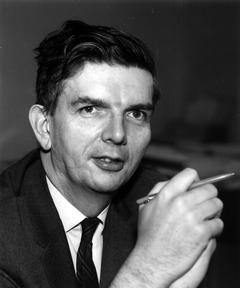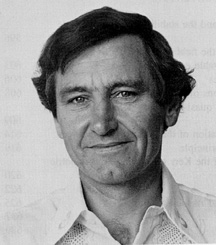<Back to Index>
- Physicist Robert Henry Dicke, 1916
- Physicist Ezra Ted Newman, 1929
- Mathematician Roy Patrick Kerr, 1934
PAGE SPONSOR

Robert Henry Dicke (May 6, 1916 – March 4, 1997) was an American physicist who made important contributions to the fields of astrophysics, atomic physics, cosmology and gravity.
Born in St. Louis, Missouri, Dicke completed his bachelor's degree at Princeton University and his doctorate, in 1939, from the University of Rochester in nuclear physics. During the Second World War he worked in the Radiation Laboratory at the Massachusetts Institute of Technology where he worked on the development of radar and designed the Dicke radiometer, a microwave receiver. He used this to set a limit on the temperature of the microwave background radiation, from the roof of the Radiation Laboratory, of less than 20 kelvins.
In 1946, he returned to Princeton University, where he remained for the rest of his career. He did some work in atomic physics, particularly on the laser and measuring the gyromagnetic ratio of the electron. An important contribution to the field of Spectroscopy and Radiative Transfer was his prediction of the phenomenon called Dicke narrowing (a.k.a. collisional narrowing): When the mean free path of an atom is much smaller than the wavelength of one of its radiation transitions, the atom changes velocity and direction many times during the emission or absorption of a photon. This causes an averaging over different Doppler states and results in an atomic linewidth that is much narrower than the Doppler width. Dicke narrowing occurs at relatively low pressures in the millimeter wave and microwave regions (where it is used in atomic clocks to improve precision). Dicke narrowing is analogous to the Mössbauer effect for gamma rays.
He spent the remainder of his career developing a program of precision tests of general relativity using the framework of the equivalence principle. With Carl H. Brans, he developed Brans - Dicke theory of gravitation, an equivalence principle violating modification of general relativity inspired by Paul Dirac's large numbers hypothesis and Mach's principle. A highlight experiment was the classic test of the equivalence principle by Roll, Krotkov and Dicke, a factor of 100 more accurate than previous work. He also made measurements of solar oblateness which were useful in understanding the perihelion precession of Mercury's orbit, one of the classical tests of general relativity.
Dirac had noted that the gravitational constant G is very roughly equal to the inverse age of the universe (in certain 'natural' units), and had concluded that G must vary to maintain this equality. Dicke realized that Dirac's relation could be a selection effect: fundamental physical laws connect G to the lifetime of what are called main sequence stars, such as our Sun, and these stars, according to Dicke, are necessary for the existence of life. At any other epoch, when the equality did not hold, there would be no intelligent life around to notice the discrepancy. This was the first modern application of what is now called the weak anthropic principle.
In the early 1960s, work on Brans - Dicke theory led Dicke to think about the early Universe, and with Jim Peebles he re-derived the prediction of a cosmic microwave background (having allegedly forgotten the earlier prediction of George Gamow and co-workers). Naturally, Dicke, with David Todd Wilkinson and Peter G. Roll immediately set about building a Dicke radiometer to search for the radiation, but they were famously scooped by the accidental detection made by Arno Penzias and Robert Woodrow Wilson (also using a Dicke radiometer), who were working at Bell Labs just a few miles from Princeton. Nevertheless, Dicke's group made the second clean detection, and their theoretical interpretation of Penzias & Wilson's results showed that theories of the early universe had moved from pure speculation into well tested physics.
Dicke (1970) gave an interesting argument that the universe must have very nearly the critical density of matter needed to stop it expanding forever. Standard models of the universe pass through stages dominated by radiation, matter, curvature etc. Transitions between stages are very special cosmic times which a priori could differ by many orders of magnitude. Since there is a non - negligible amount of matter, either we are coincidentally living close to the transition to or from the matter dominated stage, or we are in the middle of it; the latter is preferred since the coincidences are highly unlikely (an application of the Copernican principle). This implies a negligible curvature, so the universe must have almost critical density. This has been called the "Dicke coincidence" argument. In fact it gives the wrong answer, since we seem to be living at the time of transition between the matter and dark energy stages. An anthropic explanation of the failure of Dicke's argument was given by Weinberg.
Robert Dicke is also responsible for developing the lock-in amplifier, which is an indispensable tool in the area of applied science and engineering. Some believe that Robert Dicke deserved a Nobel Prize just for the invention of such a powerful and ubiquitous device. Many of Dicke's experiments capitalize on lock-in in some way or another.
In 1970, Dicke was awarded the National Medal of Science. In 1973 he was awarded the Comstock Prize in Physics from the National Academy of Sciences.
Dicke married Annie Currie in 1942. Annie, of Scottish descent, was born in Barrow - in - Furness in England in 1920 and as a young girl immigrated to Rochester, NY, via Australia and New Zealand, of which Annie had very fond memories. To her dying day, Annie would state that Australia was nice but New Zealand was Utopia.
At the beginning of World War II Robert was asked to assist the war effort by applying his skills to the development of radar with the Massachusetts Institute of Technology. Therefore, this is where they began their married life. During this time, Annie became friends with a number of the wives of other professors working on similar projects. However due to security concerns none of them knew what their husbands' work entailed and could never discuss it.
At the end of the war, Robert and Annie moved to Princeton, New Jersey, where Robert was on the faculty at Princeton University. Robert died there March 4, 1997. Annie continued to live in Princeton until 2002. For the last years of her life she lived in Hightstown, New Jersey, at Meadow Lakes Retirement Community until her death in 2005.
They had one daughter, Nancy born in 1945, and two sons, John born in
1946 and James born in 1953. At the time of Robert's death they had six
grandchildren and two great grandchildren.

Ezra Ted Newman (b. October 17, 1929) is an American physicist, known for his many contributions to general relativity theory. He is Professor Emeritus at the University of Pittsburgh. Newman was awarded the 2011 Einstein Prize from the American Physical Society:
Newman was born in the Bronx, New York City. He showed an early interest in science, pondering magnets, match flames and science books. He was admitted to the Bronx High School of Science, where he excelled at physics. Ted's father hoped that he would follow him into dentistry, but instead Ted enrolled at NYU to further his study of physics.For outstanding contributions to theoretical relativity, including the Newman - Penrose formalism, Kerr - Newman solution, Heaven, and null foliation theory. For his intellectual passion, generosity and honesty, which have inspired and represented a model for generations of relativists.
Newman was a prominent contributor to the golden age of general relativity (roughly 1960 - 1975). In 1962, together with Roger Penrose, he introduced the powerful Newman - Penrose formalism for working with spinorial quantities in general relativity. In 1963, Newman and two coworkers discovered the NUT vacuum, an exact vacuum solution to the Einstein field equation which has become a famous "counterexample to everything". In 1965, he discovered the Kerr - Newman electrovacuum, one of the best known of all exact solutions. Newman has continued to make important contributions. Some of his most interesting work has involved the problem of reconstructing the gravitational field within some region from observations of how optical images are lensed as light rays pass through the region. An email he forwarded to John C. Baez help to touch off the Bogdanov Affair.
His son, David E. Newman, is currently a Professor of Physics at the University of Alaska Fairbanks and his daughter, Dara Newman, is raising a family following a career in quantitative genetics and conservation biology.

Roy Patrick Kerr CNZM (born 16 May 1934) is a New Zealand mathematician who is best known for discovering the Kerr vacuum, an exact solution to the Einstein field equation of general relativity. His solution models the gravitational field outside an uncharged rotating massive object, including (most famously) a rotating black hole.
Kerr's mathematical talent was first recognized while he was still a high school student at St Andrew's College, Christchurch. Although there was no maths teacher there at the time he was able in 1951 to go straight into third year Mathematics at the Canterbury University College of the University of New Zealand, the precursor to the University of Canterbury. Their regulations did not permit him to graduate until 1954 and so it was not until September 1955 that he moved to the University of Cambridge, where he earned his Ph.D. in 1959. His dissertation concerned the difficult problem of the equations of motion in general relativity.
After a stint as a postdoctoral student at Syracuse University, where Einstein's collaborator Peter Bergmann was professor, he spent some time working for the United States Air Force at Wright - Patterson Air Force Base. Kerr speculated that the "main reason why the US Air Force had created a General Relativity section was probably to show the Navy that they could also do pure research."
In 1962 Kerr moved to the University of Texas at Austin, where in 1963, he discovered the Kerr vacuum solution. In 1965, with Alfred Schild, he introduced the concept of Kerr - Schild spacetimes. During his time in Texas, Kerr supervised four Ph.D. students. Kerr was interviewed about his work on the solution for the book Cracking the Einstein Code: Relativity and the Birth of Black Hole Physics, for which he also wrote an afterword.
In 1971, Kerr returned to the University of Canterbury in New Zealand, where he remained until his retirement in 1993. Kerr retired from his position as Professor of Mathematics at the University of Canterbury in 1993 after having been there for twenty - two years, including ten years as the head of the Mathematics department.
In 2008 Kerr was appointed to the Yevgeny Lifshitz ICRAnet Chair in Pescara, Italy.
His life was the subject of the semi - biographical book Cracking the Einstein Code by Fulvio Melia, published in 2009.